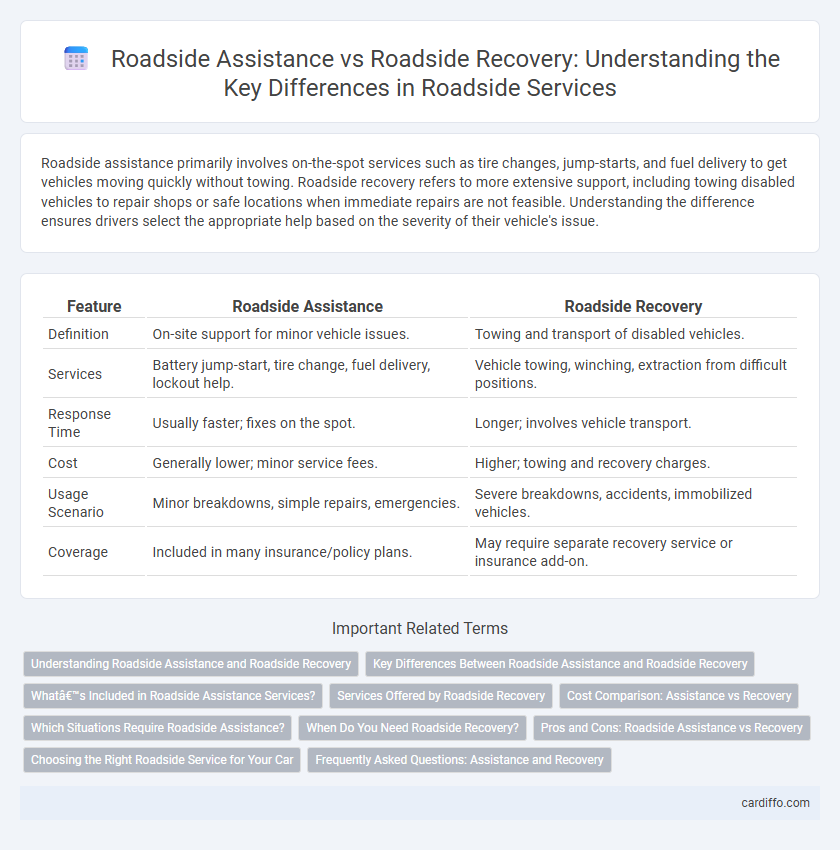Roadside assistance primarily involves on-the-spot services such as tire changes, jump-starts, and fuel delivery to get vehicles moving quickly without towing. Roadside recovery refers to more extensive support, including towing disabled vehicles to repair shops or safe locations when immediate repairs are not feasible. Understanding the difference ensures drivers select the appropriate help based on the severity of their vehicle's issue.
Table of Comparison
| Feature | Roadside Assistance | Roadside Recovery |
|---|---|---|
| Definition | On-site support for minor vehicle issues. | Towing and transport of disabled vehicles. |
| Services | Battery jump-start, tire change, fuel delivery, lockout help. | Vehicle towing, winching, extraction from difficult positions. |
| Response Time | Usually faster; fixes on the spot. | Longer; involves vehicle transport. |
| Cost | Generally lower; minor service fees. | Higher; towing and recovery charges. |
| Usage Scenario | Minor breakdowns, simple repairs, emergencies. | Severe breakdowns, accidents, immobilized vehicles. |
| Coverage | Included in many insurance/policy plans. | May require separate recovery service or insurance add-on. |
Understanding Roadside Assistance and Roadside Recovery
Roadside assistance provides immediate support for minor vehicle issues such as flat tires, dead batteries, and fuel delivery, ensuring drivers can quickly resume their journeys. Roadside recovery involves more comprehensive services like towing and vehicle extraction when a car cannot be repaired on-site or is involved in an accident. Understanding the distinction between roadside assistance and roadside recovery helps drivers select appropriate coverage based on their needs and potential roadside emergencies.
Key Differences Between Roadside Assistance and Roadside Recovery
Roadside assistance provides immediate help for minor vehicle issues such as flat tires, battery jumps, or fuel delivery directly at the breakdown location, ensuring quick get-back-on-the-road solutions. Roadside recovery involves towing services and more extensive vehicle removal when repairs on-site are not feasible, typically requiring specialized equipment to transport the vehicle to a repair facility. The key difference lies in the scope of services: assistance addresses minor, quick fixes at the roadside, while recovery manages vehicle extraction and transport after severe breakdowns or accidents.
What’s Included in Roadside Assistance Services?
Roadside assistance services typically include emergency fuel delivery, tire changes, battery jump-starts, lockout services, and minor mechanical repairs at the scene. These services provide temporary help to get drivers safely back on the road without the need for towing. Unlike roadside recovery, which involves towing and vehicle removal, assistance focuses on quick, on-site solutions to common breakdown issues.
Services Offered by Roadside Recovery
Roadside recovery services specialize in providing comprehensive vehicle extraction and towing solutions, including winching, flatbed towing, and off-road recoveries, designed to safely remove vehicles from difficult or hazardous locations. These services extend beyond basic roadside assistance by addressing situations like vehicle immobilization due to mechanical failure, accidents, or terrain challenges, ensuring safe transport to repair facilities. Roadside recovery is essential for scenarios requiring heavy-duty equipment and expert handling to prevent further damage to the vehicle.
Cost Comparison: Assistance vs Recovery
Roadside assistance typically costs less, averaging between $50 to $150 per service call, as it involves minor repairs or simple tasks like tire changes and battery jumps. Roadside recovery, involving vehicle towing or extraction from difficult locations, can range from $100 to $300 or more depending on distance and complexity. Choosing assistance over recovery can significantly reduce expenses while resolving common roadside issues quickly.
Which Situations Require Roadside Assistance?
Roadside assistance is essential for minor vehicle issues such as flat tires, dead batteries, or running out of fuel, where quick, on-the-spot help can restore mobility. It is most effective in situations requiring tire changes, battery jumps, lockout services, or fuel delivery without the need for towing. Unlike roadside recovery, which involves towing vehicles from accident sites or severe breakdowns, roadside assistance addresses immediate vehicle malfunctions that do not require extensive repairs.
When Do You Need Roadside Recovery?
Roadside recovery is essential when a vehicle cannot be repaired or started on-site, such as after severe mechanical failures, accidents, or when stuck in inaccessible locations. Unlike roadside assistance, which covers minor issues like tire changes or battery jump-starts, recovery involves towing or transporting the vehicle to a repair facility. Immediate roadside recovery becomes crucial to prevent further damage and ensure safety when the vehicle is immobilized or poses a hazard on the road.
Pros and Cons: Roadside Assistance vs Recovery
Roadside assistance provides quick, on-the-spot help such as tire changes, fuel delivery, and jump-starts, minimizing wait time and getting drivers back on the road swiftly; however, it may not address severe mechanical failures. Roadside recovery offers comprehensive vehicle towing and transport services when repairs cannot be made on-site, ensuring safe delivery to repair facilities but often involves longer wait times and higher costs. Choosing between roadside assistance and recovery depends on the vehicle issue's severity and urgency, balancing cost-effectiveness with the service's scope.
Choosing the Right Roadside Service for Your Car
Roadside assistance offers quick help for minor car issues like flat tires, dead batteries, or fuel delivery, while roadside recovery involves towing and more extensive vehicle extraction after breakdowns or accidents. Choosing the right roadside service depends on the severity of your car's problem, location, and urgency; roadside assistance is ideal for on-the-spot repairs, whereas recovery is necessary when your vehicle cannot be driven safely. Understanding the distinction ensures faster, more efficient support tailored to your car's specific needs on the road.
Frequently Asked Questions: Assistance and Recovery
Roadside assistance typically covers minor vehicle issues such as flat tires, dead batteries, or lockouts, providing quick help to get drivers back on the road. Roadside recovery involves towing or extracting vehicles that cannot be immediately repaired at the scene, often due to accidents or severe mechanical failures. Frequently asked questions center on service availability, response time, coverage limits, and whether the service includes both assistance and recovery options.
Roadside assistance vs roadside recovery Infographic

 cardiffo.com
cardiffo.com